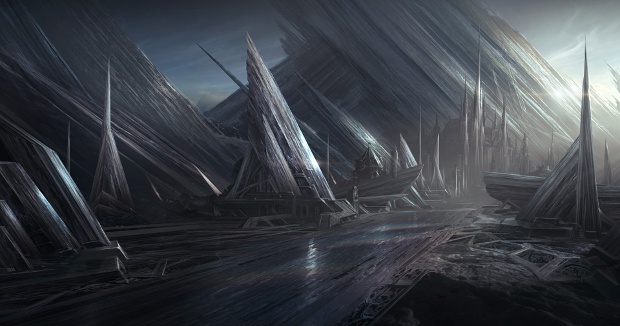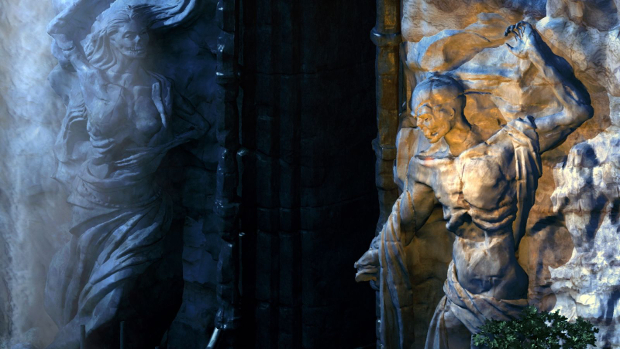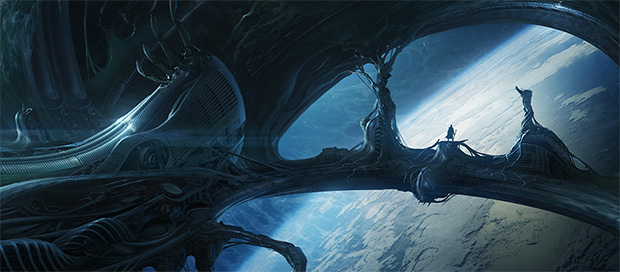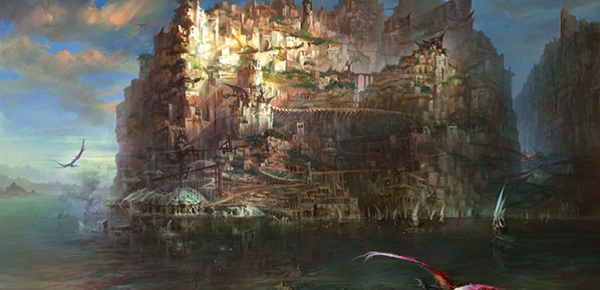- Joined
- Jan 28, 2011
- Messages
- 99,621















Tags: Adam Heine; George Ziets; InXile Entertainment; Kevin Saunders; Torment: Tides of Numenera
The prolific Nathan Grayson of Rock Paper Shotgun has managed to score a multi-part "Ultimate Interview" with the lead developers of Torment: Tides of Numenera - Kevin Saunders, Colin McComb, Adam Heine and George Ziets. The first part of the interview lives up to that description, with a detailed look at Torment's extensive preproduction process, as well as its systems and combat. As usual for a Torment-related piece, I can't possibly quote it all, so here's an excerpt:
The prolific Nathan Grayson of Rock Paper Shotgun has managed to score a multi-part "Ultimate Interview" with the lead developers of Torment: Tides of Numenera - Kevin Saunders, Colin McComb, Adam Heine and George Ziets. The first part of the interview lives up to that description, with a detailed look at Torment's extensive preproduction process, as well as its systems and combat. As usual for a Torment-related piece, I can't possibly quote it all, so here's an excerpt:
RPS: It’s been more than a year since Torment’s Kickstarter wrapped up. What’s the pre-production process been like? How do you sit down and design a game like this? What do you prioritize?
Saunders: It’s been a combination of defining the breadth of the game at increasing levels of detail, while also delving into the very specifics for the most critical or risky elements. One aspect we prioritized early was the conversations. Adam Heine and Colin McComb were writing dialogue for the game soon after the Kickstarter campaign ended. We wanted to establish how we’d tell the story and imbue our conversations with as much reactivity as possible without making them prohibitively time-consuming to design and write.
Establishing our conventions for conversation design, and having in-game examples of them, was especially important given our host of writing talent.
Last summer, one of the systems Adam was working on was crafting. At that time, most of our design documentation was at a fairly high level, but Adam had some specific inspiration and thoughts about how crafting might work. So he ran with it, diving into a much deeper level of detail than most of our design at that time. Crafting touches many other aspects of the design: items, character abilities, loot and advancement, etc. Determining the details of that one system helped inform parts of many other systems, providing obvious answers for other design decisions and propelling our understanding of the game forward.
This is illustrative of our general approach – charging into the details whenever those are clear, and favoring this depth over the broad strokes. Right now, for example, we don’t have the specifics of every area in the game planned out. (Even so, we have written over 200K words of area design documentation.) Instead, we've brought the design of one major section of the game to considerable detail and are focusing energy on implementing and iterating on it so that we can learn more about the specifics and thus get closer to our target when we do turn our attention to other areas.
RPS: You decided to make some pretty big changes to the game’s story. Without spoiling too much, what was it like initially? What did you decide needed changing?
Saunders: Despite the major changes we’ve made to the story over the last year, what we said about the overarching story during the Kickstarter is still accurate. Perhaps today’s synopsis of the story would emphasize some different elements, but the premise and flavor are the same. Some of the finest details are, too – though most of what we revealed during the Kickstarter is uncovered by the player in the first 10% or so of the game anyway – we want to make sure our backers have plenty of surprises. Colin had strong core ideas; he has a story he wants to tell and that hasn’t changed.
But in our efforts to achieve the player experience he’s envisioning, we’ve adjusted some of the specifics of how the story unfolds – how and when the PC learns various pieces of it, for example. Chris Avellone, George Zeits, and Nathan Long all provided input here, which Adam, Colin, and I (mostly Colin) used in figuring out how to enhance the flow of the narrative. One aspect we spent considerable energy on was detailing the motivations of the various characters, including the PC. We challenged the “why” behind people taking certain actions and looked for ways to improve the pacing through the PC’s own motivations.
RPS: One area where you’ve gone off the road paved by Planescape is combat. You’re opting for turn-based even though PST was real-time with pause. What kind of turn-based combat are we talking, though? How intricate will it be? What are your main influences on that front? Which other turn-based games?
Heine: Combat was one of those things in Planescape that many felt was lacking. We had plans to greatly improve it from the beginning, and as those plans solidified over the months after the Kickstarter, we saw how a turn-based system was better suited for them – especially the Crisis plan. Wasteland 2 designer Jeremy Kopman built a Crisis prototype based upon Wasteland 2, that proved the concept would work. At that point, we favored turn-based combat internally, but we wanted to know how the backers would feel about the shift from RTwP to TB. So we explained our thoughts to the backers, asked for discussion, and put it to a vote. Both the vote and the discussions were split right down the middle.
But those discussions have helped clarify and solidify our ideas. We learned what people don’t like about turn-based combat and come up with ways to address those issues. In many cases, our existing plans had addressed those issues before the backers even raised them, which was very encouraging.
We have a lot of influences for turn-based. One that stands out is Temple of Elemental Evil. I hadn’t played this game before the combat vote, but as soon as I did I knew this was a good foundation for Torment. Specifically the way they handled gridless turn-based, move vs. attack actions, and a wealth of tactical choices for the player. The Fire Emblem games have been another formative influence for Crises in general, specifically the idea of goals and actions beyond just “kill the other guy.” While you can certainly fight your way through most Crises, players will frequently have other options as well, like interacting with the environment to use it to your advantage, talking to NPCs to persuade them to help you, etc. And of course we’re learning a lot from Wasteland 2 and the feedback that project has received regarding pure tactical combat.
It appears that despite its much extended preproduction time as compared to Wasteland 2 and Pillars of Eternity, there are still plenty of areas in Torment that will only be finalized during the actual production, by the junior writers and area designers. Iteration now, iteration tomorrow, iteration forever, I guess.Saunders: It’s been a combination of defining the breadth of the game at increasing levels of detail, while also delving into the very specifics for the most critical or risky elements. One aspect we prioritized early was the conversations. Adam Heine and Colin McComb were writing dialogue for the game soon after the Kickstarter campaign ended. We wanted to establish how we’d tell the story and imbue our conversations with as much reactivity as possible without making them prohibitively time-consuming to design and write.
Establishing our conventions for conversation design, and having in-game examples of them, was especially important given our host of writing talent.
Last summer, one of the systems Adam was working on was crafting. At that time, most of our design documentation was at a fairly high level, but Adam had some specific inspiration and thoughts about how crafting might work. So he ran with it, diving into a much deeper level of detail than most of our design at that time. Crafting touches many other aspects of the design: items, character abilities, loot and advancement, etc. Determining the details of that one system helped inform parts of many other systems, providing obvious answers for other design decisions and propelling our understanding of the game forward.
This is illustrative of our general approach – charging into the details whenever those are clear, and favoring this depth over the broad strokes. Right now, for example, we don’t have the specifics of every area in the game planned out. (Even so, we have written over 200K words of area design documentation.) Instead, we've brought the design of one major section of the game to considerable detail and are focusing energy on implementing and iterating on it so that we can learn more about the specifics and thus get closer to our target when we do turn our attention to other areas.
RPS: You decided to make some pretty big changes to the game’s story. Without spoiling too much, what was it like initially? What did you decide needed changing?
Saunders: Despite the major changes we’ve made to the story over the last year, what we said about the overarching story during the Kickstarter is still accurate. Perhaps today’s synopsis of the story would emphasize some different elements, but the premise and flavor are the same. Some of the finest details are, too – though most of what we revealed during the Kickstarter is uncovered by the player in the first 10% or so of the game anyway – we want to make sure our backers have plenty of surprises. Colin had strong core ideas; he has a story he wants to tell and that hasn’t changed.
But in our efforts to achieve the player experience he’s envisioning, we’ve adjusted some of the specifics of how the story unfolds – how and when the PC learns various pieces of it, for example. Chris Avellone, George Zeits, and Nathan Long all provided input here, which Adam, Colin, and I (mostly Colin) used in figuring out how to enhance the flow of the narrative. One aspect we spent considerable energy on was detailing the motivations of the various characters, including the PC. We challenged the “why” behind people taking certain actions and looked for ways to improve the pacing through the PC’s own motivations.
RPS: One area where you’ve gone off the road paved by Planescape is combat. You’re opting for turn-based even though PST was real-time with pause. What kind of turn-based combat are we talking, though? How intricate will it be? What are your main influences on that front? Which other turn-based games?
Heine: Combat was one of those things in Planescape that many felt was lacking. We had plans to greatly improve it from the beginning, and as those plans solidified over the months after the Kickstarter, we saw how a turn-based system was better suited for them – especially the Crisis plan. Wasteland 2 designer Jeremy Kopman built a Crisis prototype based upon Wasteland 2, that proved the concept would work. At that point, we favored turn-based combat internally, but we wanted to know how the backers would feel about the shift from RTwP to TB. So we explained our thoughts to the backers, asked for discussion, and put it to a vote. Both the vote and the discussions were split right down the middle.
But those discussions have helped clarify and solidify our ideas. We learned what people don’t like about turn-based combat and come up with ways to address those issues. In many cases, our existing plans had addressed those issues before the backers even raised them, which was very encouraging.
We have a lot of influences for turn-based. One that stands out is Temple of Elemental Evil. I hadn’t played this game before the combat vote, but as soon as I did I knew this was a good foundation for Torment. Specifically the way they handled gridless turn-based, move vs. attack actions, and a wealth of tactical choices for the player. The Fire Emblem games have been another formative influence for Crises in general, specifically the idea of goals and actions beyond just “kill the other guy.” While you can certainly fight your way through most Crises, players will frequently have other options as well, like interacting with the environment to use it to your advantage, talking to NPCs to persuade them to help you, etc. And of course we’re learning a lot from Wasteland 2 and the feedback that project has received regarding pure tactical combat.















![The Year of Incline [2014] Codex 2014](/forums/smiles/campaign_tags/campaign_incline2014.png)


![Glory to Codexia! [2012] Codex 2012](/forums/smiles/campaign_tags/campaign_slushfund2012.png)
![Have Many Potato [2013] Codex 2013](/forums/smiles/campaign_tags/campaign_potato2013.png)














